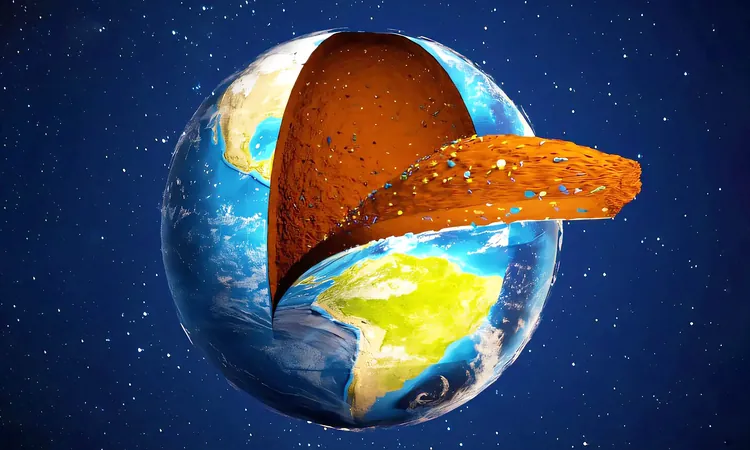
Groundbreaking Discovery: New Microbe Phylum Unearthed in Earth's Hidden Depths!
2025-04-13
Author: Rajesh
Unlocking Earth's Secrets Beneath Our Feet
Microbes are all around us, but some of the most vital players in our ecosystems are concealed deep beneath the Earth's surface. A fascinating new study has unveiled a previously unknown group of microbes that are flourishing in deep soil, discreetly performing the crucial task of purifying our drinking water.
The Mysteries of the 'Critical Zone'
Researchers at Michigan State University have embarked on a journey to explore a largely uncharted territory of our planet known as Earth's "Critical Zone." This zone extends from the lofty treetops down to depths of around 700 feet and serves as a fundamental layer that governs essential ecological processes.
As microbiology expert James Tiedje highlights, this zone plays a critical role in regulating water purification, nutrient cycling, and soil formation, all of which are vital for food production and ecosystem vitality. Yet, the deeper parts remain shrouded in mystery.
Meet CSP1-3: A New Phylum of Microbes!
In a groundbreaking discovery, scientists analyzed deep soil samples from Iowa and China and identified an entirely new phylum of microbes, christened CSP1-3. This classification represents a significant leap in biological categorization, indicating not just a new species but a completely new chapter in microbial life.
Their research indicates that these microbes could be more widespread than previously thought, hinting at a hidden but abundant world beneath our feet.
A Microbial Journey Through Time
The researchers extracted DNA from these soil samples and traced back the evolutionary lineage of CSP1-3. Surprisingly, their ancestors were once aquatic organisms, thriving in environments like freshwater and hot springs millions of years ago before adapting to life in soil.
What sets CSP1-3 apart is not just their existence but their remarkable activity; they are not simply dormant spores. Tiedje notes that these microbes are actively growing, with some samples revealing that CSP1-3 comprises over half of the microbial community—a rarity in soil ecosystems.
Nature's Water Purifiers
Soil is not just dirt; it is the Earth’s largest natural water filter. As rainwater percolates through the soil layers, it undergoes rigorous cleaning through various physical and biological processes. While surface layers play a part, a significant portion of water purification occurs at deeper levels, where CSP1-3 come into play.
These hard-working microbes act as scavengers, breaking down leftover carbon and nitrogen that trickles down from the topsoil, thereby enhancing the quality of our groundwater before it reaches the aquifers that provide our drinking water.
What's Next for Science?
The research team is now focused on cultivating CSP1-3 in controlled lab conditions, an endeavor known for its challenges due to the specific requirements of deep-soil microbes. Leveraging the knowledge that their ancestors thrived in hot springs, the team plans to experiment with elevated temperatures to facilitate growth.
The potential applications of understanding CSP1-3 could be monumental. Scientists are eager to uncover their capabilities for metabolizing tough pollutants, which may help address some of the most critical environmental issues we face today.
A Paradigm Shift in Soil Research
As Leonardo da Vinci wisely noted, "We know more about the movement of celestial bodies than about the soil underfoot." With findings like CSP1-3, we are beginning to change our understanding of what lies beneath, layer by layer.
This groundbreaking study has been published in the esteemed journal Proceedings of the National Academy of Sciences, opening up new avenues for exploration and appreciation for the hidden worlds beneath our everyday lives.



 Brasil (PT)
Brasil (PT)
 Canada (EN)
Canada (EN)
 Chile (ES)
Chile (ES)
 Česko (CS)
Česko (CS)
 대한민국 (KO)
대한민국 (KO)
 España (ES)
España (ES)
 France (FR)
France (FR)
 Hong Kong (EN)
Hong Kong (EN)
 Italia (IT)
Italia (IT)
 日本 (JA)
日本 (JA)
 Magyarország (HU)
Magyarország (HU)
 Norge (NO)
Norge (NO)
 Polska (PL)
Polska (PL)
 Schweiz (DE)
Schweiz (DE)
 Singapore (EN)
Singapore (EN)
 Sverige (SV)
Sverige (SV)
 Suomi (FI)
Suomi (FI)
 Türkiye (TR)
Türkiye (TR)
 الإمارات العربية المتحدة (AR)
الإمارات العربية المتحدة (AR)